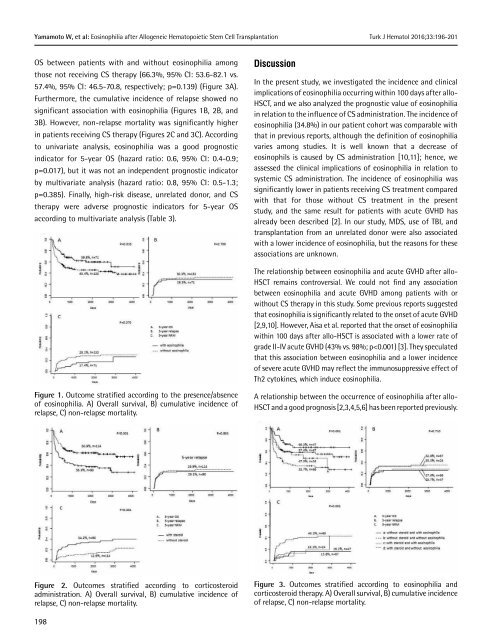Turkish Journal of Hematology Volume: 33 - Issue: 3
Create successful ePaper yourself
Turn your PDF publications into a flip-book with our unique Google optimized e-Paper software.
Yamamoto W, et al: Eosinophilia after Allogeneic Hematopoietic Stem Cell Transplantation Turk J Hematol 2016;<strong>33</strong>:196-201<br />
OS between patients with and without eosinophilia among<br />
those not receiving CS therapy (66.3%, 95% CI: 53.6-82.1 vs.<br />
57.4%, 95% CI: 46.5-70.8, respectively; p=0.139) (Figure 3A).<br />
Furthermore, the cumulative incidence <strong>of</strong> relapse showed no<br />
significant association with eosinophilia (Figures 1B, 2B, and<br />
3B). However, non-relapse mortality was significantly higher<br />
in patients receiving CS therapy (Figures 2C and 3C). According<br />
to univariate analysis, eosinophilia was a good prognostic<br />
indicator for 5-year OS (hazard ratio: 0.6, 95% CI: 0.4-0.9;<br />
p=0.017), but it was not an independent prognostic indicator<br />
by multivariate analysis (hazard ratio: 0.8, 95% CI: 0.5-1.3;<br />
p=0.385). Finally, high-risk disease, unrelated donor, and CS<br />
therapy were adverse prognostic indicators for 5-year OS<br />
according to multivariate analysis (Table 3).<br />
Discussion<br />
In the present study, we investigated the incidence and clinical<br />
implications <strong>of</strong> eosinophilia occurring within 100 days after allo-<br />
HSCT, and we also analyzed the prognostic value <strong>of</strong> eosinophilia<br />
in relation to the influence <strong>of</strong> CS administration. The incidence <strong>of</strong><br />
eosinophilia (34.8%) in our patient cohort was comparable with<br />
that in previous reports, although the definition <strong>of</strong> eosinophilia<br />
varies among studies. It is well known that a decrease <strong>of</strong><br />
eosinophils is caused by CS administration [10,11]; hence, we<br />
assessed the clinical implications <strong>of</strong> eosinophilia in relation to<br />
systemic CS administration. The incidence <strong>of</strong> eosinophilia was<br />
significantly lower in patients receiving CS treatment compared<br />
with that for those without CS treatment in the present<br />
study, and the same result for patients with acute GVHD has<br />
already been described [2]. In our study, MDS, use <strong>of</strong> TBI, and<br />
transplantation from an unrelated donor were also associated<br />
with a lower incidence <strong>of</strong> eosinophilia, but the reasons for these<br />
associations are unknown.<br />
The relationship between eosinophilia and acute GVHD after allo-<br />
HSCT remains controversial. We could not find any association<br />
between eosinophilia and acute GVHD among patients with or<br />
without CS therapy in this study. Some previous reports suggested<br />
that eosinophilia is significantly related to the onset <strong>of</strong> acute GVHD<br />
[2,9,10]. However, Aisa et al. reported that the onset <strong>of</strong> eosinophilia<br />
within 100 days after allo-HSCT is associated with a lower rate <strong>of</strong><br />
grade II-IV acute GVHD (43% vs. 98%; p

















